
Antenna
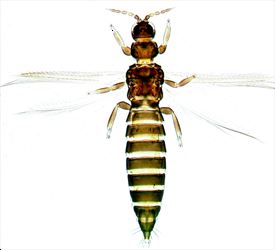
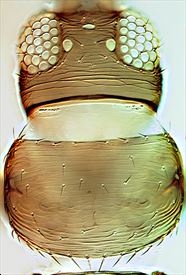
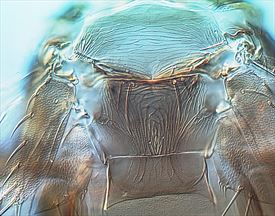
Meso & metanotum
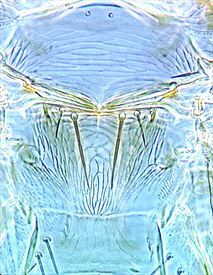
Meso & metanotum
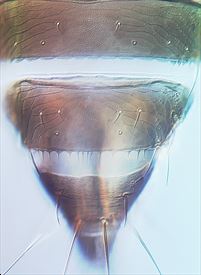
Tergites VII-X
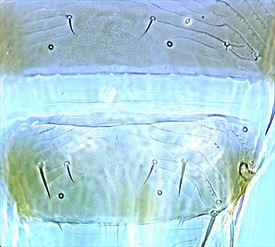
Tergites VII-VIII

Fore wing

Male sternites V-VIII
Distinguishing features
Both sexes fully winged. Body usually brown, tarsi, fore tibiae and antennal segment III paler; fore wings weakly shaded to light brown with base paler. Antennae 8-segmented, III–IV each with small, forked sense cone. Head wider than long; vertex, including ocellar triangle, with transverse sculpture lines; 3 pairs of ocellar setae, pair III small, arising between hind ocelli; 4 pairs of small postocular setae. Pronotum with transverse lines of sculpture, no long setae; posterior margin with 7 pairs of setae, median posteromarginals scarcely longer than remaining marginals. Mesonotal and metanotal campaniform sensilla variable, present or absent. Metanotum with lines of sculpture converging posteromedially; median setae arise at anterior margin. Mesofurca with spinula. Fore wing first and second veins with complete row of setae; clavus with 6 veinal setae. Tergites without craspeda; V–VII without ctenidia, VIII with paired ctenidia anterolateral to spiracle, posteromarginal comb comprising about 6 long microtrichia medially with smaller triangular teeth laterally. Sternites without discal setae; VII with setae S1 arising at margin.
Male similar to female but smaller, sometimes paler; sternites III–VII with transverse pore plate; sternite VIII posterior margin with long slender microtrichia arising from triangular bases, preceding sternites sometimes with posteromarginal microtrichia.
Related species
Species of the genus Pseudanaphothrips share many character states with species of Frankliniella, but none of them has tergal ctenidia so well-formed. Currently the genus includes nine species, all but one from Australia. P. achaetus is readily distinguished, because it is the only member of the genus with no elongate pronotal posteroangular setae. Populations differ in the presence of campaniform sensilla, both on the mesonotum and on the metanotum. Moreover, adults on yellow-flowered species of Hakea and Banksia in Australia are commonly yellow not brown. These variants are all considered to represent one species.
Biological data
This highly polyphagous thrips feeds and breeds within the flowers of various native and also introduced plant species.
Distribution data
Widespread in Australia, but also introduced to Hawaii, California, and New Zealand (AK, CL, BP, TO/NN, MB, BR, KA, MC, CO).
Family name
THRIPIDAE, THRIPINAE
Species name
Pseudanaphothrips achaetus (Bagnall)
Original name and synonyms
Pseudothrips achaetus Bagnall, 1916: 398
References
Mound LA, Tree DC & Paris D (2012) OzThrips – Thysanoptera in Australia. http://www.ozthrips.org/
Mound LA & Walker AK (1982) Terebrantia (Insecta: Thysanoptera). Fauna of New Zealand 1: 1–113.